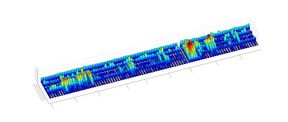Space weather can be trying for Arctic regions – new technique aids space weather forecasting

Researchers at Aalto University have developed a new technique which can be used for analysing fluctuations in the Earth’s magnetic field. The method presented in the Space Weather journal was used to study magnetic field changes in different years and at different times of the day and different latitudes.
There were significant differences in the behaviour of the magnetic field at different observation stations: the northernmost stations were more geomagnetically active at midday, while the activeness at the southernmost stations was highest at midnight. The largest differences between different times of day was observed in the northernmost measurement zone, in the Arctic Circle.
‘The Fractional Derivative Rate (FDR) technique that we have developed calculates for each day percentage which indicates how often the activeness of the magnetic field has reached a level of 0.2 nT/s (nanoteslas per second) on that day. This value corresponds to the typical initial stage of a substorm, which is one of the most common space weather phenomena. This technique makes it easier to analyse high resolution observation data for long periods of time’, explains Doctoral Candidate Pyry Peitso.
Magnetic field can be used to forecast space weather
The precise research and understanding of latitudinal differences in geomagnetic activeness is important because this information will help to produce better and more precise space weather forecasts. Often, different kind of space weather phenomena can be seen quickly and clearly in the magnetic field.
‘The economic significance of the Arctic region is increasing. This means that space weather forecasting will become more important, because space weather impacts on many different kinds of infrastructure and business activities in the Arctic region, including electricity networks, oil and gas pipes, mining operations, aviation and shipping.’
Space weather can manifest itself, for example, as quick variations of the magnetic field, which can cause undesired electrical flows in different infrastructure components. These electrical flows cause many kinds of problems, such as material deterioration.
The article analysed observation data that was collected in Greenland from 2011 to 2013. The researchers made use of twelve observation stations which all produced high quality measurements at one second intervals. On its north-south axis, the observation station network covered a distance of 2000 kilometres.
Peitso, P., Tanskanen, E. I., Pulkkinen, T. I., & Mursula, K. (2018). High-frequency geomagnetic fluctuations at auroral oval and polar cap. Space Weather, 16, 1057–1072. https://doi.org/10.1029/2018SW001841
Caption: Measurements from Greenland during 2011 January to March, darker colour denotes higher activity. Stations are grouped from north to south. Strong activity can be observed during the beginning of March from most of the stations.
Further information:
Pyry Peitso
+358 504205870
[email protected]
Aalto University
School of Electrical Engineering
- Published:
- Updated:
Read more news

Broadband miniaturized spectrometer research receives QTF annual discovery award 2024
The clarity and compelling presentation of the research were one of the reasons why Doctoral Researcher Md Uddin earned the prize for the research paper, which was published in Nature Communications.
Robotics needs safe behavior patterns
Robotics and autonomous systems are developing rapidly. Algorithms that withstand disturbances and uncertainties in the system model and environment are critical for development.